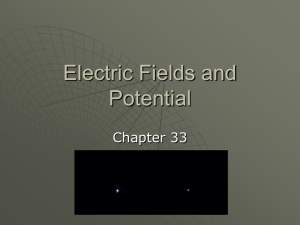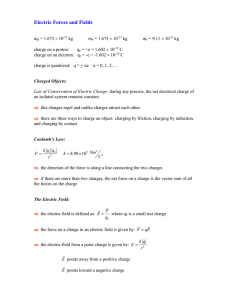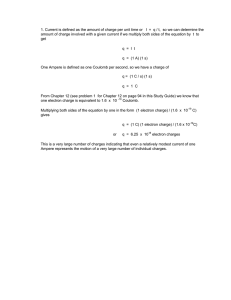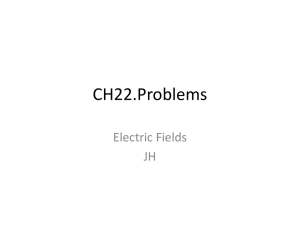1 In which way is the electric force similar to the gravitational force
advertisement
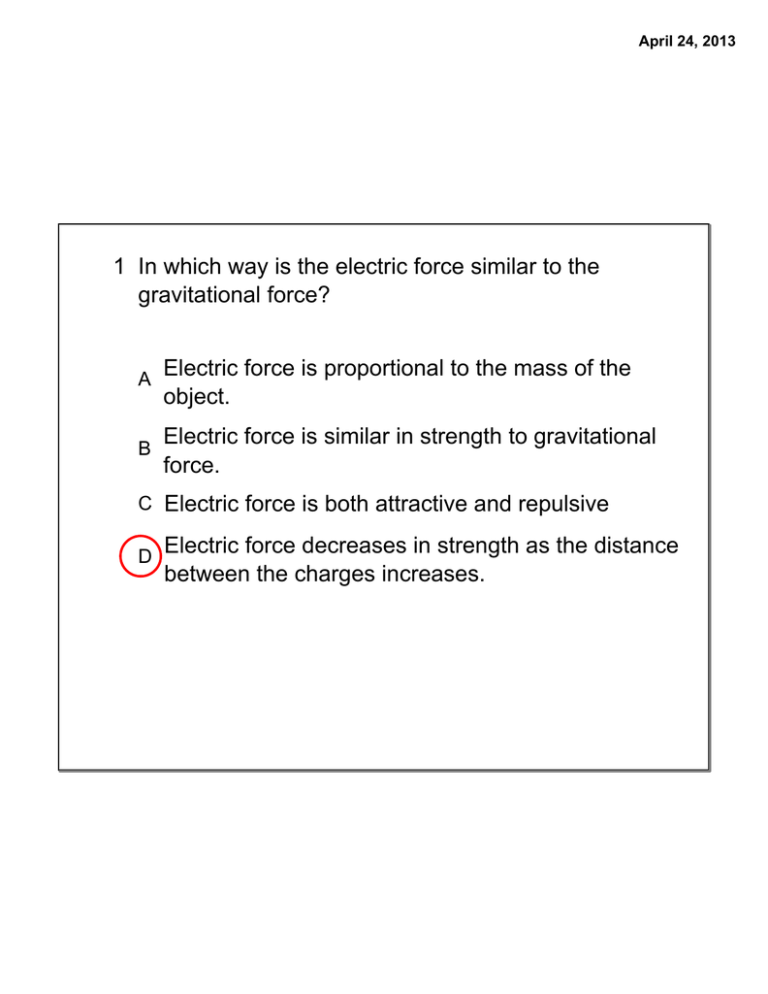
April 24, 2013 1 In which way is the electric force similar to the gravitational force? A Electric force is proportional to the mass of the object. B Electric force is similar in strength to gravitational force. C Electric force is both attractive and repulsive D Electric force decreases in strength as the distance between the charges increases. April 24, 2013 2 What must the charges be for A and B in the figure shown so that they produce the electric field lines shown? A A and B must both be positive B A and B must both be negative C A must be negative; B must be positive D A must be positive; B must be negative April 24, 2013 3 Which activity does not produce the same results as the other three? A Sliding over a plastic-covered automobile seat. B Walking across a woolen carpet. C Scraping food from a metal bowl with a metal spoon. D Brushing dry hair with a plastic comb. April 24, 2013 4 By how much does the electric force between two charges change when the distance between them is doubled? A factor of 4 This question would not appear B factor of 2 on the test "as is." You might C factor of 1/2 asks about "increasing" or D factor of 1/4 specifically about the factor. face a similar question that "decreasing" but not April 24, 2013 5 A negatively charged object is brought close to the surface of a conductor, whose opposite side is then grounded. What is this process of charging called? A Charging by contact B Charging by induction C Charging by conduction D Charging by polarization April 24, 2013 6 A negatively charged object is brought close to the surface of a conductor, whose opposite side is then grounded (similar to #5). What kind of charge is left on the conductor's surface? A neutral B negative C positive D both positive and negative April 24, 2013 7 What changes would take place if the electron moved from point A to point B in the uniform electric field shown? A B C The electron's electrical PE would increase; its V would increase. The electron's electric PE would increase; its V would decrease. The electron's PE would decrease; its V would decrease. D The electron's PE would increase; its V would increase. E Neither the PE nor its V would change. April 24, 2013 8 What changes would take place if the electron moved from point A to point C in the uniform electric field? A B C D The electron's electrical PE would increase; its V would increase. The electron's electrical PE would increase; its V would decrease. The electron's electrical PE would decrease; its V would decrease. The electron's electrical PE would decrease; its V would increase. E Neither PE nor V would change. April 24, 2013 9 A proton (q=1.6 x 10-19 C) moves 2.0 x 10-6 m in the direction of an electric field that has a magnitude of 2.0 N/C. What is the change in the electrical PE associated with the proton? We haven't dealt with the equation A - 6.4 x 10-25 J necessary for this question. Don't B - 4.0 x 10-6 J were given ΔV = -4.0 x 10–6 volts, C + 6.4 x 10-25 J D + 4.0 x 10-6 J expect it on the test. However, if you then you should be able to solve this. You should be able to know that ΔPE must be negative from the question. April 24, 2013 10 A proton (q=1.6 x 10-19 C) moves 2.0 x 10-6 m in the direction of an electric field that has a magnitude of 2.0 N/C. (similar to #9) What is the potential difference between the proton's starting point and ending point? A - 6.4 x 10-25 V B - 4.0 x 10-6 V C + 6.4 x 10-25 V D + 4.0 x 10-6 V We haven't dealt with the equation necessary for this question. Don't expect it on the test. April 24, 2013 11 A potential difference of 12 V produces a current of 0.40 A in a piece of copper wire. What is the resistance of the wire? A 4.8 Ω B 12 Ω C 30 Ω D 36 Ω April 24, 2013 12 How many Joules of energy are dissipated by a 50.0 W light bulb in 2.00 s? A 25.0 J B 50.0 J C 100 J D 200 J April 24, 2013 13 How much power is needed to operate a radio that draws 7.0 A of current when a potential difference of 115 V is applied across it? A 0.061 W B 2.3 W C 16 W D 800 W April 24, 2013
